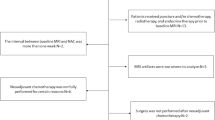Abstract
In this paper, we present a method of quantifying the heterogeneity of cervical cancer tumors for use in radiation treatment outcome prediction. Features based on the distribution of masked wavelet decomposition coefficients in the tumor region of interest (ROI) of temporal dynamic contrast-enhanced magnetic resonance imaging (DCE-MRI) studies were used along with the imaged tumor volume to assess the response of the tumors to treatment. The wavelet decomposition combined with ROI masking was used to extract local intensity variations in the tumor. The developed method was tested on a data set consisting of 23 patients with advanced cervical cancer who underwent radiation therapy; 18 of these patients had local control of the tumor, and five had local recurrence. Each patient participated in two DCE-MRI studies: one prior to treatment and another early into treatment (2–4 weeks). An outcome of local control or local recurrence of the tumor was assigned to each patient based on a posttherapy follow-up at least 2 years after the end of treatment. Three different supervised classifiers were trained on combinational subsets of the full wavelet and volume feature set. The best-performing linear discriminant analysis (LDA) and support vector machine (SVM) classifiers each had mean prediction accuracies of 95.7%, with the LDA classifier being more sensitive (100% vs. 80%) and the SVM classifier being more specific (100% vs. 94.4%) in those cases. The K-nearest neighbor classifier performed the best out of all three classifiers, having multiple feature sets that were used to achieve 100% prediction accuracy. The use of distribution measures of the masked wavelet coefficients as features resulted in much better predictive performance than those of previous approaches based on tumor intensity values and their distributions or tumor volume alone.









Similar content being viewed by others
References
Franco EL, Schlecht NF, Saslow D: The epidemiology of cervical cancer. Cancer J 9(5):348–359, 2003
Khan FM Ed: Treatment planning in radiation oncology. 2nd ed. Philadelphia: Lippincott Williams & Wilkins, 2007
Choyke PL, Dwyer AJ, Knopp MV: Functional tumor imaging with dynamic contrast-enhanced magnetic resonance imaging. J Magn Reson Imaging 17(5):509–520, 2003
Hawighorst H, Knapstein PG, Knopp MV, Weikel W, Brix G, Zuna I, et al: Uterine cervical carcinoma: Comparison of standard and pharmacokinetic analysis of time-intensity curves for assessment of tumor angiogenesis and patient survival. Cancer Res 58(16):3598–3602, 1998, Aug
Noworolski SM, Henry RG, Vigneron DB, Kurhanewicz J: Dynamic contrast-enhanced MRI in normal and abnormal prostate tissues as defined by biopsy, MRI, and 3D MRSI. Magn Reson Med 53(2):249–255, 2005
Padhani AR, Gapinski CJ, Macvicar DA, Parker GJ, Suckling J, Revell PB, et al: Dynamic contrast enhanced MRI of prostate cancer: Correlation with morphology and tumour stage, histological grade and PSA. Clin Radiol 55(2):99–109, 2000
George ML, Dzik-Jurasz ASK, Padhani AR, Brown G, Tait DM, Eccles SA, et al: Non-invasive methods of assessing angiogenesis and their value in predicting response to treatment in colorectal cancer. Br J Surg 88(12):1628–1636, 2001
Wang B, Gao ZQ, Yan X: Correlative study of angiogenesis and dynamic contrast-enhanced magnetic resonance imaging features of hepatocellular carcinoma. Acta Radiol 46:353, 2005
Furman-Haran E, Schechtman E, Kelcz F, Kirshenbaum K, Degani H: Magnetic resonance imaging reveals functional diversity of the vasculature in benign and malignant breast lesions. Cancer 104(4):708–718, 2005
Mayr NA, Yuh WT, Magnotta VA, Ehrhardt JC, Wheeler JA, Sorosky JI, et al: Tumor perfusion studies using fast magnetic resonance imaging technique in advanced cervical cancer: A new noninvasive predictive assay. Int J Radiat Oncol Biol Phys 36(3):623–633, 1996, Oct 1
Mayr NA, Yuh WT, Arnholt JC, Ehrhardt JC, Sorosky JI, Magnotta VA, et al: Pixel analysis of MR perfusion imaging in predicting radiation therapy outcome in cervical cancer. J Magn Reson Imaging 12(6):1027–1033, 2000, Dec
Loncaster JA, Carrington BM, Sykes JR, Jones AP, Todd SM, Cooper R, et al: Prediction of radiotherapy outcome using dynamic contrast enhanced MRI of carcinoma of the cervix. Int J Radiat Oncol Biol Phys 54(3):759–767, 2002, Nov 1
Prescott JW, Zhang D, Wang JZ, Mayr NA, Yuh WTC, Saltz J, et al: In: Cancer treatment outcome prediction by assessing temporal change: Application to cervical cancer. Proc. of SPIE Med Img, San Diego, 2008
Prescott JW, Zhang D, Wang JZ, Mayr NA, Yuh WTC, Saltz J, et al: In: Outcome prediction for radiation treatment of cervical cancer by assessing tumor heterogeneity and temporal change. OSUMC Research Day, April 10, 2008
Mallat SG: A theory for multiresolution signal decomposition: The wavelet representation. IEEE Trans Pattern Anal Mach Intell 11(7):674–693, 1989
Gurcan MN: Detection of microcalcifications in mammograms using higher order statistics. IEEE Signal Process Lett 4(8):213–216, 1997
Duda RO, Hart PE, Stork DG: Pattern classification, Wiley: New York, 2001
Zijdenbos AP, Dawant BM, Margolin RA, Palmer AC: Morphometric analysis of white matter lesions in MR images: Method and validation. IEEE Trans Med Imag 13:716–724, 1994, Dec
Author information
Authors and Affiliations
Corresponding author
Rights and permissions
About this article
Cite this article
Prescott, J.W., Zhang, D., Wang, J.Z. et al. Temporal Analysis of Tumor Heterogeneity and Volume for Cervical Cancer Treatment Outcome Prediction: Preliminary Evaluation. J Digit Imaging 23, 342–357 (2010). https://doi.org/10.1007/s10278-009-9179-7
Received:
Revised:
Accepted:
Published:
Issue Date:
DOI: https://doi.org/10.1007/s10278-009-9179-7




